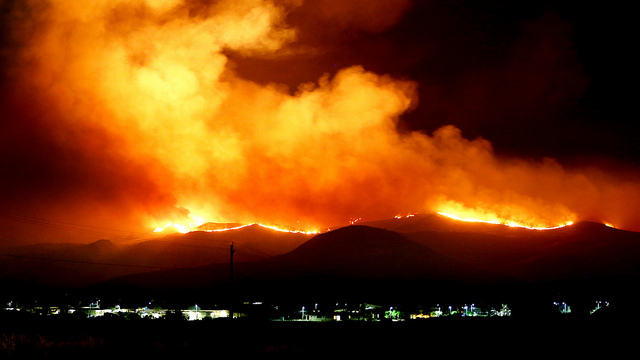
Blog |
Alex Hall: How Climate Change is Fueling Southern California Wildfires
By Alison Hewitt and Karen Lefkowitz
Soaring temperatures triggered by a serious increase in greenhouse gases in the atmosphere will intensify wildfires by the middle of this century in Southern California according to a new study by researchers from three University of California campuses and partner institutions.
 IoES’ Alex Hall and other colleagues from UCLA, along with scientists from UC Davis, UC Irvine, the U.S. Forest Service, and NASA’s Jet Propulsion Laboratory, teamed up to quantify the drivers and impacts of wildfire in the current climate, and to project future impacts given climate change. Their paper, “Identification of Two Distinct Fire Regimes in Southern California: Implications for Economic Impact and Future Change,” was published on September 4 in the scientific journal Environmental Research Letters. The projections revealed in the study can help fire agencies better prepare for coming seasons of more frequent, stronger blazes. Hall spoke with UCLA Newsroom’s Alison Hewitt on the relevance of these findings.
IoES’ Alex Hall and other colleagues from UCLA, along with scientists from UC Davis, UC Irvine, the U.S. Forest Service, and NASA’s Jet Propulsion Laboratory, teamed up to quantify the drivers and impacts of wildfire in the current climate, and to project future impacts given climate change. Their paper, “Identification of Two Distinct Fire Regimes in Southern California: Implications for Economic Impact and Future Change,” was published on September 4 in the scientific journal Environmental Research Letters. The projections revealed in the study can help fire agencies better prepare for coming seasons of more frequent, stronger blazes. Hall spoke with UCLA Newsroom’s Alison Hewitt on the relevance of these findings.
Q: What will “fuel” the increased burning you’re projecting in Southern California by mid-century?
Alex Hall: There are two types of fires. The Santa Ana-driven fires happen mainly in the fall, after the summertime dryness and before the rain, when the vegetation is very vulnerable to fire. The very low moisture of the Santa Ana winds has a desiccating effect on the vegetation, drying it out still further. By mid-century, climate change will have driven down the relative humidity of the Santa Ana winds even more, increasing their ability to spread fire.
The other type of fires is the non-Santa Ana fires, which are much more common in the summertime. They’re driven not so much by the wind but by the extreme heat, which makes the vegetation much more susceptible to ignition.
Q: What did your lab provide for the study?
Alex Hall: My lab provided all the current climate data for the fire models, and we generated the future-climate predictions by downscaling global climate models.
Our climate predictions assume a “business as usual” scenario, where there are no significant reductions in greenhouse gas emissions. However, in previous studies, we’ve found that even when we use a scenario of significant reduction in greenhouse gases, climate models show mid-century warming increases to about 70 percent of the “business as usual” scenario. We can infer that even if we mitigate climate change, the growth in fire damage would be smaller, but not dramatically so.
“Even if we mitigate climate change, the growth in fire damage would be smaller, but not dramatically so.”
Q: Why do fires driven by the Santa Anas seem to cause more economic damage than others? And why do you think other wildfires will start to cause similar levels of damage?
Alex Hall: The Santa Ana fires are much larger currently, and tend to spread into the urban-wildland interface. Non–Santa Ana fires tend to occur in places like the National Forest, where there are fewer structures. But as they get bigger, they could start to intrude into inhabited areas.
We found that non–Santa Ana fires will play a larger role in the overall fire risk for Southern California. Those are the types of fires that will change more in the future, and we will become more vulnerable to the non–Santa Ana types of fires. This is a new way of seeing fire and fire risk in Southern California, and in a sense it extends the fire season. Right now, Santa Anas really dominate the sense of there being a “fire season.” The non–Santa Anas will come to really dominate in the summer.
Q: Why is this research important? Why should people care about how wildfires could grow?
Alex Hall: Wildfires are obviously very destructive of property. We live in a region where people have built into the wild, and that urban-wildland interface is vulnerable to fire.
These wildfires have an impact on people and on our water resources. For example, the 2009 Station Fire deposited a large amount of ash, and when the rains came, a lot of it got washed into the reservoirs. There’s still a huge build-up of ash in these reservoirs, making it difficult to use the water.
Finally, wildfire is a really critical element of the ecosystem in Southern California. It’s a natural aspect of the ecology, and a change in wildfire leads to a change in the ecology. So if we care about conserving our natural resources, we have to understand how these changes in wildfires would impact our ecosystems.
